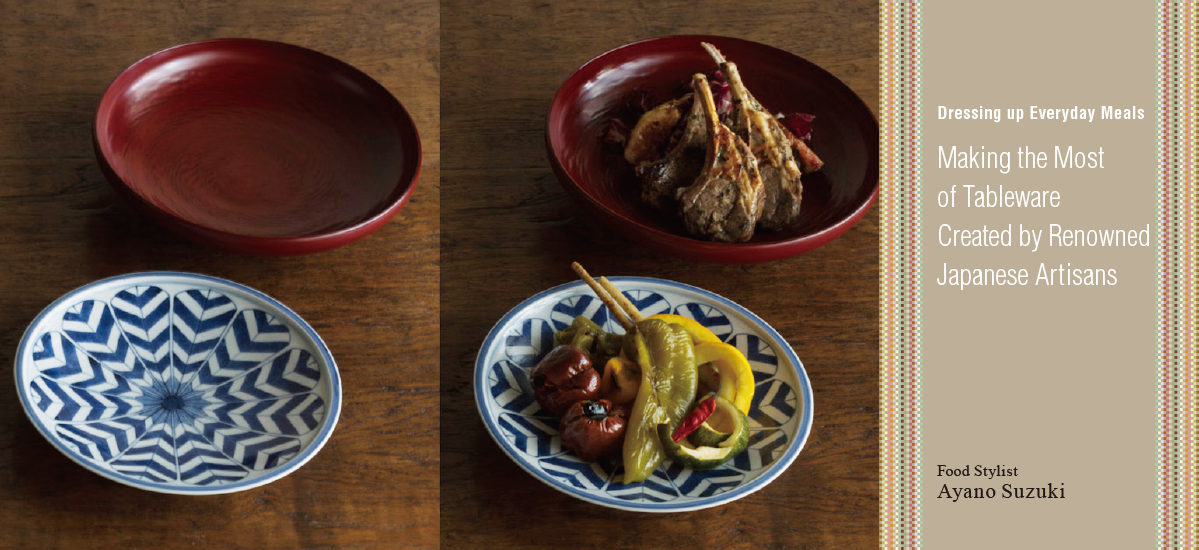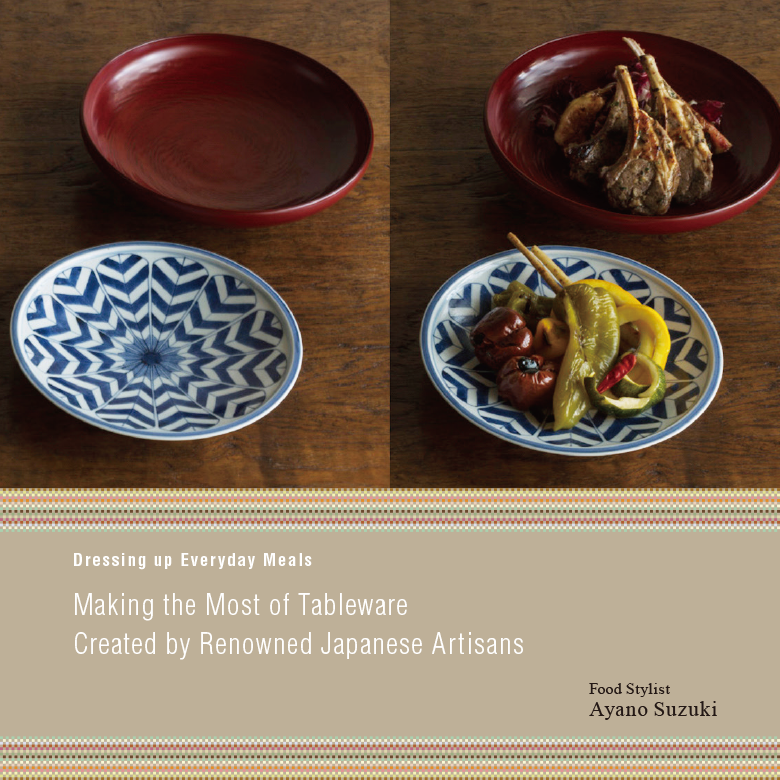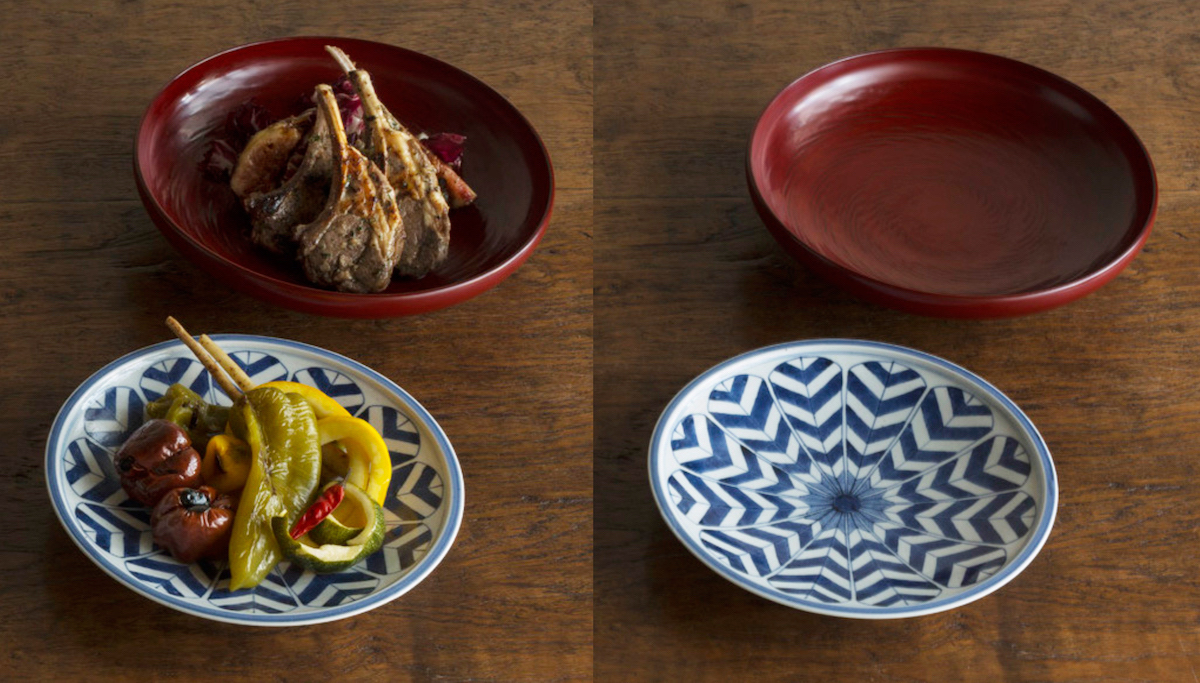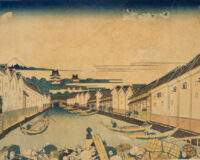

One of the most striking things when it comes to Japanese tableware is the sheer variety of exquisite, hand-crafted items available. Perhaps you already have a beautiful set of lacquered bowls; or a collection of porcelain platters that you love to display, their bright patterns vivid against a pure white ground. Or was it a ceramic bowl that you just couldn’t resist at a pottery fair?
While these beautiful dishes are lovely to have and display, how many of us are still waiting for that special day when we’ll actually use them?
But why wait for a special occasion? The beautiful dishes produced by today’s craftspeople are intended to be used, not just admired. What’s more, they have the power to transform the ordinary dining table into something quite extraordinary.
Food stylist Ayano Suzuki shares her tips on food and tableware pairings that make the most of pieces created by some of Japan’s best-known artisans.
Text : 舟橋 愛 Ai Funahashi / Food Stylist : 鈴木 理乃 Ayano Suzuki / English Version : Judy Evans
Keyword : Minoru Suzuki / Cooking / Tadami Iwamoto / Lacquerware / Pottery / Kitaoji Rosanjin / Ceramics / Jun'ichiro Hakose / Shinji Terauchi
“If clothes make the person, then dishes make the food.” Putting the words of artistic genius Rosanjin into practice.
Kitaōji Rosanjin, internationally-renowned ceramicist, lacquer artist, painter, calligrapher, and cook (just some of the myriad talents he developed in his life-long pursuit of art and cuisine) understood that utilitarian tableware was simply missing the point. Rosanjin (1883-1959) believed that good food deserves good crockery, arguing that presentation is an important aspect of flavour. His commitment to this ideal was such that, unable to find tableware that lived up to his cuisine, he created his own.
Almost a century has passed since Rosanjin lamented the lack of suitable tableware. In Japan there is now an absolute plethora of tableware available, from lacquerware to pottery to porcelain; from affordable to aspirational. Modern eating habits happily mix Japanese and Western-style cuisine, and Japanese tableware, much of it highly idiosyncratic, has kept pace with changing lifestyles.
Let’s take a look at how traditional tableware crafted by modern artisans can enliven Western-style dishes and, at the same time, lift the spirits.
Hearty Lamb Chops in a Chiselled Lacquerware Bowl and Festively-Coloured Vegetables on Dignified Blue-and-White China

In the world of hand-crafted lacquerware, the various processes involved in making a single piece are usually carried out by different artisans, each specialising in one aspect of the process. Lacquerware artist Jun’ichi Hakose, however, likes to see to the entire process, from the finer details of the carving to the final application of lacquer. Hakose-san is internationally renowned for his modernist motifs in makie (gold lacquer), but he also creates simple, plainly-lacquered tableware such as our first piece, where the focus is on the wood itself.
Food stylist Ayano Suzuki chose to pair Jun’ichi Hakose’s lacquer bowl with lamb chops. “The way this bowl is carved, the chisel marks spiral up from the base to the outer rim like a whirlpool. I felt that this bold piece, with its woody feel, would work well with lamb on the bone,” she told us. As the bowl is quite deep, the food needs to be arranged three-dimensionally. Another point is that the food ingredients Suzuki-san has chosen are all of a similar hue to the bowl, complementing rather than competing with the deep red of the lacquer.
As unconventional as it may be to serve meat on lacquerware, these lamb chops look right at home in Hakose-san’s robust lacquerware bowl.
Our second piece is an Arita-ware plate by Shinji Terauchi, decorated with a blue arrow-feather (yabane) pattern. Terauchi-san’s ongoing mission is “to create Arita-ware for modern dining”. He also sees to the entire process, including creating the porcelain pieces and decorating them himself. With its traditional arrow-feather design in blue glaze radiating out from the centre, the pattern on this plate seems to pulsate with hidden energy!
Suzuki-san’s approach was to select vegetables with colours that work well with the blue, grilling the vegetables before pickling them. “The arrow-feather pattern is striking, so the plate alone is photo-worthy,” she said. “This plate also has some depth, so it works well with foods served in sauces.”
This arrow-feather pattern certainly packs a punch and sets off the varied colours of the pickled vegetables perfectly. This is just the kind of cooling dish that would go down well with beer on a hot summer’s evening – a feast for the eyes and for the palate!
“Vermillion Serving Bowl” by Jun’ichi Hakose, Paired With Marinated Sautéed Lamb Served on a Fig Salad

Ingredients (serves two)
4 lamb chops
Marinade:
2 tablespoons white wine
1 tablespoon white balsamic vinegar (or white wine vinegar)
½ teaspoon crushed garlic
3 sprigs thyme (leaves only, finely chopped)
½ sprig rosemary (leaves only, finely chopped)
1 teaspoon sugar
1 teaspoon salt
Salad to garnish:
2 figs
3 leaves red chicory, torn into smaller pieces
1 tablespoon olive oil
Balsamic Glaze:
2 tablespoons balsamic vinegar
1 tablepoon vodka
Pinch of salt
Sprinkle of pepper
Instructions:
- The previous day, combine the marinade ingredients and marinate the lamb chops overnight, massaging in the marinade to ensure even coverage.
- Wash figs and cut each one into 4 – 6 equal parts. Combine gently with the torn chicory leaves and olive oil.
- To make the balsamic glaze, heat the balsamic vinegar in a small pan until just simmering. Add the vodka, salt and pepper. Reduce over a low heat until the glaze thickens.
- Heat a little oil in a frying pan. Remove the lamb chops from the marinade. Sauté in the frying pan until nicely browned. Arrange the chops over the salad on a serving plate. Pour the balsamic glaze over the chops.
Shinji Terauchi’s Arrow-Feather Pattern Plate, With Pickled Grilled Seasonal Vegetables

Ingredients (serves two)
2 Manganji peppers (mild, sweet capsicum shaped like a large chili pepper)
2 thin lengths of burdock root, about 15 cm each
4 mini red bell peppers
½ round zucchini, seeds removed
Pickling liquid:
200ml vinegar
60ml water
4 whole cloves
7 whole black peppercorns
1 red chili pepper
1 bay leaf
⅓ teaspoon ground paprika
1 teaspoon sugar
½ teaspoon salt
Instructions:
- Place pickling ingredients in a saucepan. Heat until just simmering and remove from heat.
- Meanwhile, grill the vegetables and cut them into manageable pieces.
- While still hot, pack the vegetables into a jar large enough to hold the pickling liquid. Pour the hot liquid over the vegetables, screw the lid on and leave to cool. Refrigerate for 24 hours before serving.
Striking Celtic-Inspired Pottery With Paccheri Pasta and an Italian Dessert in a Rustic Lacquered Bowl

Potter Minoru Suzuki, who has his studio in the iconic pottery village of Mashiko, specialises in a molding technique known as wari-gata, or “split mold”. He works with local clay and glaze ingredients to create warm, modern pieces which he decorates with Celtic-inspired patterns. The “Celtic Pattern Square Plate” we selected features an eye-catching circular design that seem to dance like waves rippling onto the shore.
“I took my inspiration from this pattern, which makes me think of rings somehow multiplying, and decided to have a play with short tube pasta. The big, bold shape of the pasta is set off by the heavy earthenware with its bold circular pattern,” explains stylist, Ayano Suzuki.
The idea of rings multiplying is definitely an interesting one, and our stylist has achieved a great sense of unity by pairing this dish with the tubular paccheri pasta. The colour of the apricot in the ingredients adds a tiny dash of orange to the pasta, while the green pattern and rich brown ameyū glaze really do “dress up” this fairly plain dish.
Our final piece is Tadami Iwamoto’s “Kuri Soup Bowl”, a wooden bowl with a sombre matt lacquer finish. The true genius of Iwamoto-san’s work lies in the way the he tenderly carves each piece as if in a conversation with the wood. Iwamoto-san’s bowl is all the more beautiful for being slightly elliptical rather than perfectly round. Holding this quirky bowl in your hands, you really do get a strong sense of the wood it was carved from.
Suzuki-san says that she was rather excited at the thought of using this traditional-looking lacquerware bowl for Western-style food. “It’s relatively large for a Japanese soup bowl, and has quite a high base, which reminded me a bit of a compote dish. This gave me the idea of using it in a similar way as a compote or candy dish, so I chose the Italian sweet, cassata.”
Suzuki-san explains that the sombreness of the bowl pairs well with the slight astringency in the skin of the shibukawa-nicandied chestnuts in the cassata, but that the lightness of the dessert balances the bowl’s serious tone. “Also,” she continues, “since the wooden bowl doesn’t conduct heat, I thought it made sense to use it for a chilled dessert.”
Another great pairing, with the white cassata appearing to float up as if from a dark abyss. What a statement this would make if you happened to casually serve it one day with tea!
Minoru Suzuki’s “Celtic Pattern Square Plate” with Gorgonzola and Apricot Paccheri

Ingredients (serves two)
160g paccheri (tube pasta)
10g salt for boiling the pasta
30ml white wine
40g gorgonzola cheese
100ml cream
25g dried apricots, finely chopped
5g butter
salt and coarsely ground black pepper
15g walnuts, finely chopped
dash of olive oil
Instructions:
- Bring approx. 1 litre of water to the boil in a large saucepan. Add the 10g of salt and pasta. Boil approx. 14 minutes or according to manufacturer’s directions.
- Meanwhile, heat white wine in a frying pan then reduce heat immediately. Add the gorgonzola and cream, stirring to melt the cheese and blend. Allow to thicken a little, then add the dried apricots.
- Season with the butter and salt and pepper.
- Dress the pasta in the sauce and arrange on a serving plate. Sprinkle with chopped walnuts and coarsely ground black pepper. Drizzle with a dash of olive oil to serve.
“Kuri Soup Bowl” by Tadami Iwamoto, with Shibukawani and Rum Nut Cassata.

Ingredients (makes one loaf pan)
2 egg whites
18g sugar
200ml cream
250g ricotta cheese
Fruit and nut filling:
5 shibukawani candied chestnuts, each cut into 2 or 3 pieces
20g mixed raisins
40g pistachios
2 tablespoons cacao nibs
1 tablespoon rum
1 tablespoon honey
Instructions:
- Mix fruit and nut filling ingredients together in advance. Set aside to absorb the flavours of the honey and rum.
- Beat the egg whites and sugar together until stiff peaks form. Separately, beat the cream until firm but not overbeaten. Fold into egg white mixture. Gently fold in the ricotta cheese and fruit and nut mixture.
- Scoop into a loaf pan and level the top. Refrigerate at least 6 hours or overnight, until firm. Cut into squares to serve.
Text: Ai Funahashi. Editor and writer. Production editor, Able-Fool Corporation.
Food: Ayano Suzuki. Food stylist. Studied cooking in Florence, Italy. Working as a food stylist for magazines, advertising and film since 2006. Creates recipes and is sought after as a guest speaker. Holds the “Rum Concierge” qualification.








